Mitosis versus Meiosis
| Read about mitosis >> | Read about meiosis >> |
Mitosis versus Meiosis
There are two kinds of eukaryotic cell division: mitosis and meiosis (see figure, below right). Mitosis, unlike meiosis, is a duplication process: It produces two genetically identical daughter cells from a single parent cell.

|
|
Image derived from a drawing by Saperaud |
You yourself grew from a single embryonic cell to the person you are now through mitosis. Even after growth of the body is complete, mitosis continues, replacing cells lost through everyday wear and tear. The constant replenishment of your skin cells, for example, occurs through mitosis. Mitosis takes place in all parts of your body, keeping your tissues and organs in good working order.
Meiosis, on the other hand, is quite different. It shuffles the genetic deck, generating daughter cells that are distinct from one another and from the original parent cell. Although nearly all the different types of cells in your body can undergo mitosis, meiosis in human beings occurs only in cells that will become either eggs or sperm. So, in humans, mitosis is for growth and maintenance, while meiosis is for sexual reproduction.
|
Related Topics:
|
Five Key Differences
- In meiosis, homologous chromosomes pair with each other (i.e., they form tetrads) and crossing-over occurs. In mitosis, neither of these things occur.
- In metaphase I of meiosis, tetrads align on the metaphase plate. In metaphase of mitosis, individual chromosomes align there.
- In anaphase I of meiosis, centromeres don't divide, and sister chromatids don't separate. In mitotic anaphase, they do.
- In meiosis there are two successive divisions, ultimately producing four daughter cells. In mitosis, there is only one division and it produces two daughter cells.
- Another important difference in comparing mitosis versus meiosis is that meiotic prophase I lasts far longer than does mitotic prophase. In fact, it is broken into several named substages, which is not the case for mitotic prophase.
Note, however, that meiosis II is very similar to mitosis (in that sister chromatids separate from each other in both) — the only significant difference is that in meiosis II there is a single member from each chromosome pair present, whereas in mitosis both members of each chromosome pair are present.